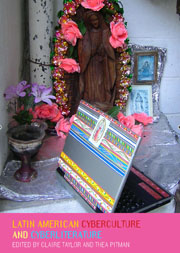Book contents
- Frontmatter
- Contents
- List of Illustrations
- Acknowledgements
- Foreword: Latin American Cyberliterature: From the Lettered City to the Creativity of its Citizens
- Notes on Contributors
- Introduction
- I Cyberculture and Cybercommunities
- II Cyberliterature: Avatars and Aficionados
- 9 Posthumanism in the Work of Jorge Luis Borges
- 10 Julio Cortázar's Rayuela and the Challenges of Cyberliterature
- 11 Contemporary Brazilian Fiction: Between Screens and Printed Pages
- 12 Creative Processes in Hypermedia Literature: Single Purpose, Multiple Authors
- 13 Hypertext in Context: Space and Time in the Hypertext and Hypermedia Fictions of Blas Valdez and Doménico Chiappe
- 14 Virtual Bodies in Cyberspace: Guzik Glantz's Weblog
- A Cyberliterary Afterword: Of Blogs and Other Matters
- Conclusion: Latin American Identity and Cyberspace
- Suggested Further Reading
- Index
11 - Contemporary Brazilian Fiction: Between Screens and Printed Pages
from II - Cyberliterature: Avatars and Aficionados
- Frontmatter
- Contents
- List of Illustrations
- Acknowledgements
- Foreword: Latin American Cyberliterature: From the Lettered City to the Creativity of its Citizens
- Notes on Contributors
- Introduction
- I Cyberculture and Cybercommunities
- II Cyberliterature: Avatars and Aficionados
- 9 Posthumanism in the Work of Jorge Luis Borges
- 10 Julio Cortázar's Rayuela and the Challenges of Cyberliterature
- 11 Contemporary Brazilian Fiction: Between Screens and Printed Pages
- 12 Creative Processes in Hypermedia Literature: Single Purpose, Multiple Authors
- 13 Hypertext in Context: Space and Time in the Hypertext and Hypermedia Fictions of Blas Valdez and Doménico Chiappe
- 14 Virtual Bodies in Cyberspace: Guzik Glantz's Weblog
- A Cyberliterary Afterword: Of Blogs and Other Matters
- Conclusion: Latin American Identity and Cyberspace
- Suggested Further Reading
- Index
Summary
Introduction: Benjamin, Simmel, Lévy
The intersection of literature and information technology prompts a number of theoretical questions. These are not necessarily new, but they take on new dimensions as the Internet reshapes the cycle of production, transmission, and consumption of the written word. Such questions include the changing roles of reader and author made possible by the advent of hypertext and the practice of the collective creation of texts, as well as debates about the notions of author and work, in the light of the intensification of techniques such as collage, montage, appropriation, and re-creation as processes of artistic creation, and the ongoing erosion of the ‘aura’ of the work of art (Benjamin 1970b). They also include delicate matters such as the ascription of authorship and subsequent questions of copyright – an area where legislation clearly needs revising and updating in accordance with this new mode of transmission of a literary text; and the redefinition of the criteria by which we ascribe value to the literary text, in view of its transmission in the midst of a multiplicity of other types of texts, images and sounds.
Any reflection upon the social changes brought about by new media must entail analysing the new forms of interaction that are enabled between media and society. In other words, we should move from the analysis of the media as such to an analysis of social mediations (Martín-Barbero 1993).
- Type
- Chapter
- Information
- Latin American Cyberculture and Cyberliterature , pp. 207 - 215Publisher: Liverpool University PressPrint publication year: 2007



